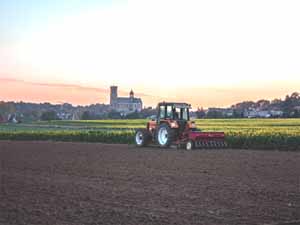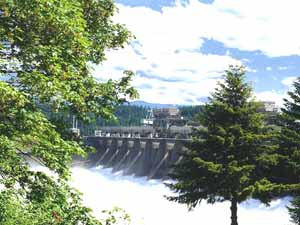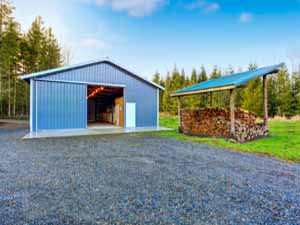The robust shape of a wooden barn has been entwined with the classic image of a farm for years. However, as times change, more and more contemporary farmers are choosing steel barns — a more inventive solution.
While traditional barns have their charms, modern farmers find steel barns to be a more appealing alternative due to their numerous advantages. Fabric structures also offer numerous benefits and should be considered alongside steel barns. Let’s look at the key factors your farm should consider when choosing between steel, Fabric Structures, and traditional barns.
Comparing Initial and Ongoing Expenses of Steel Vs. Traditional Barns
Although a steel barn may first appear more expensive than a conventional wooden barn, a closer examination paints a more complex picture. With its exceptional durability and low maintenance requirements, steel may save a lot of money in the long term.
You won’t have to plan for ongoing painting, termite treatment, or warping or rot repair — common problems with wooden buildings. To further lower the overall cost, certain steel buildings are also eligible for tax incentives as agricultural assets.
Durability and Longevity: Built to Last
Steel is considered a durable and strong material since strong winds, a lot of snow, and even fire (if properly coated to prevent flames) may all be tolerated by steel barns. This means that your rigid steel buildings will survive longer and may even last for decades.
So, compared to wood, steel is much more stable and has a higher breaking strength. This makes the barn’s open areas broader, which is perfect for holding big gear or equipment.

Maintenance and Upkeep: More Farming, Less Time
When it comes to upkeep, steel barns need less care than traditional wooden barns. Here’s how steel makes life easier for you:
Minimal Repairs: Steel requires fewer replacements and repairs over time due to its resilience to decay, insects, and weather damage.
Simple Cleaning: Steel surfaces are smooth and simple to clean, which makes it simpler to keep your crops and animals in a sanitary environment.
Painting: Steel barns can be painted for aesthetic reasons, although it is not required for structural stability. Repainting is not necessary for the structure to be maintained, unlike wood.
You can concentrate more of your time on managing your farm and less time on upkeep with a steel barn.
Flexibility and Suitability: Getting What You Need
Steel barns are incredibly flexible and can adapt to your changing agricultural demands.
Customization: Depending on your demands, they may be made in different sizes and layouts to accommodate equipment sheds, workshops, animal housing, or hay storage.
Potential for Expansion: Steel constructions can be readily extended. Your current steel barn can easily accommodate more bays if your farm develops in the future, allowing for smooth operation and expansion. Furthermore, the open layout of steel buildings — which have fewer support beams than traditional barns — allows for more effective use of available space and simpler machinery movement.
Good Insulation Options: Steel is also readily combined with insulating panels to adjust temperature, resulting in a flexible space suitable for a range of agricultural tasks.
Environmental Effects: A Sustainable Decision
Throughout their lifetime, steel barns provide several environmental benefits in addition to the fact that steel is a recyclable material.
Diminished Manufacturing Footprint: Steel has a reduced carbon footprint than traditional construction materials because steel production has become more efficient over time. Furthermore, a lot of steel producers include recycled steel in their goods, which lessens the environmental effect even more.
Energy Efficiency: It is possible to design steel buildings to use less energy. By keeping your barn cooler during the summer, metal roofing can help you use less air conditioning. Furthermore, stiff steel structures have the potential to be well-insulated, which reduces heating expenses and winter heat loss. These energy-efficient designs represent significant innovations in sustainable farming.
Long Lifespan: As previously said, steel barns are quite robust and may endure for decades with little maintenance. Steel barns, as previously shown, have an exceptionally long lifespan and require very little upkeep, often lasting decades. This reduces the demand for replacements and the negative effects that old building destruction and disposal have on the environment.

Aesthetic and Cultural Elements: A Contemporary Interpretation of Custom
Although some people might think that traditional timber constructions have more appeal than steel barns, contemporary steel barns provide a surprising amount of aesthetic versatility. Here’s how you combine form and function with steel barns:
Architectural Design Options: To create an appearance that blends in with your current farm structures, steel buildings may be created with a variety of designs, rooflines, and even features like cupolas or wainscoting.
Color Versatility: Steel barns are available in a variety of hues, so you may select a color scheme that matches your farm’s overall design or expresses your own sense of style.
Natural Light Integration: To bring in natural light, steel barn designs might use skylights and thoughtfully positioned windows.
In the end, a steel barn may be a contemporary interpretation of the classic barn design, providing your farm with a neat, useful, and visually beautiful addition. You may choose an option that meets your agricultural demands and promotes sustainability by taking into account both the advantages steel barns provide for the environment and their architectural flexibility.






Good morning
Are you farming with Sasnen Goats in South Africa.
If you are, is it possible to send a video of them to my whatsapp number +27 836183916.
Many thanks
Roelene Phillips